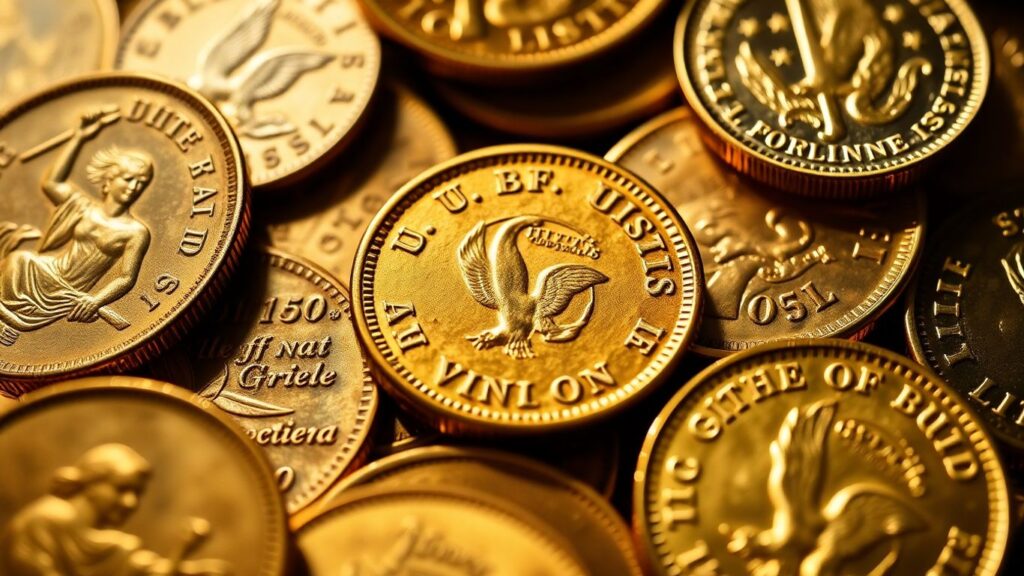Gold coins have been a part of the United States’ story for a long time. From the very first ones made to the shiny ones people collect today, there’s a lot to learn. This article looks at the history of U.S. gold coins, covering how they were made, what they looked like, and why they’re still interesting to people now. We’ll go from the early days of gold rushes to the special coins the Mint makes today. It’s a look at how these pieces of metal tell a story about America.
Key Takeaways
- The history of U.S. gold coins starts with early gold finds and the first federal mintings, including denominations like Quarter Eagles and Eagles.
- A ‘Golden Age’ saw the rise of the Double Eagle and gold coinage during significant periods like the Civil War.
- The Saint-Gaudens era brought artistic designs to gold coins, ending with pre-1933 issues.
- Modern U.S. gold coin production was revived with the Gold Bullion Coin Act of 1985, leading to the American Gold Eagle series.
- Collecting U.S. gold coins today involves understanding premiums, identifying rare dates, and using grading services.
The Dawn Of U.S. Gold Coinage
Before the United States even had its own official mint, gold was already making waves. Early discoveries, particularly in North Carolina around 1799, showed that the new nation had its own precious resources. This wasn’t California gold rush stuff yet, but it was enough to get people thinking. A farmer’s son found a big chunk of yellow rock that turned out to be gold – it even served as a doorstop for a few years! By the 1830s, private minters like the Bechtler family in North Carolina were already striking gold coins, showing there was a real demand.
Early Gold Discoveries And Their Impact
The first real push for federal gold coinage came after these early finds. It became clear that having our own gold coins would be a good idea, both for commerce and to show off the nation’s wealth. The idea was to have coins that people could actually use, not just lumps of metal.
The First Federal Gold Coins
Congress finally acted, and in 1792, they authorized the creation of the United States Mint. The first gold coins started rolling out a couple of years later, in 1795. These weren’t just any coins; they were a statement. They were meant to be a tangible representation of America’s growing economic power.
Pioneering Denominations: From Quarter Eagles to Eagles
When the Mint first opened its doors to gold, they didn’t just make one type of coin. They introduced a few different values to cover various needs. The smallest was the Quarter Eagle, worth $2.50. Then came the Half Eagle at $5, and the Eagle at $10. These denominations were chosen to fit into the existing monetary system and make transactions easier.
Here’s a look at those initial gold denominations:
| Denomination | Face Value |
|---|---|
| Quarter Eagle | $2.50 |
| Half Eagle | $5.00 |
| Eagle | $10.00 |
These coins were made with a specific amount of gold, setting the standard for U.S. gold coinage for decades to come. It was a significant step in establishing a stable and recognizable currency for the young nation.
The early days of U.S. gold coinage were driven by both the discovery of domestic gold and a desire to create a strong national currency. These first gold pieces weren’t just currency; they were symbols of a new country finding its footing and its wealth.
The Golden Age Of American Gold
This period really saw U.S. gold coins hit their stride, becoming more common and more impressive. Think bigger denominations and designs that really captured the spirit of the times. It was a time when gold coins weren’t just currency; they were symbols of prosperity and national pride.
The Rise Of The Double Eagle
The introduction of the $20 Double Eagle in 1849 was a pretty big deal. Before this, the highest denomination was the $10 Eagle. Suddenly, you had a coin that was almost an ounce of gold, with a face value that felt substantial. This massive coin was minted for a few key reasons:
- Meeting Demand: The California Gold Rush had flooded the country with gold, and larger denominations were needed to handle the increased supply.
- Facilitating Large Transactions: These coins made it easier to conduct significant business deals without needing stacks of smaller coins.
- International Trade: A $20 gold coin was a more convenient unit for international commerce compared to smaller denominations.
It’s fascinating to think about how these coins were used back then. They weren’t just pocket change; they were serious money.
Liberty Head And Indian Head Designs
When it came to looks, this era had some real winners. The Liberty Head design, often called the ‘Coronet’ type, graced the Double Eagle and other denominations from the mid-1800s into the early 1900s. It featured Lady Liberty wearing a coronet, looking quite regal. Then came the Indian Head designs, which were a bit different. For the $5 Half Eagle and $10 Eagle, artists depicted Native American chiefs wearing feathered headdresses. The $2.50 Quarter Eagle and $1 Gold Dollar also got Indian Princess designs. These designs really brought a distinct American flavor to the coinage.
Gold Coinage During The Civil War Era
The Civil War certainly threw a wrench into things, but surprisingly, gold coinage didn’t completely stop. While there were disruptions and some mints faced challenges, production continued. The demand for gold remained, and the U.S. Mint kept striking coins. It’s a testament to the country’s resilience that these valuable coins were still being produced even amidst such turmoil. Some coins from this period, especially those from Southern mints or with specific mint marks, can be quite sought after by collectors today because of their historical context and relative scarcity.
The sheer amount of gold being produced and minted into coins during this era fundamentally changed the landscape of American currency and commerce. It wasn’t just about having gold; it was about how that gold was shaped into usable, recognizable forms that fueled the nation’s growth.
The Saint-Gaudens Era And Beyond
Augustus Saint-Gaudens' Artistic Vision
Before we get to the coins themselves, it’s worth talking about the artist behind some of the most beautiful gold coins the U.S. ever produced: Augustus Saint-Gaudens. He was a big deal in the art world, known for his sculptures. President Theodore Roosevelt really admired his work and wanted to bring that artistic flair to American money. Roosevelt felt that U.S. coins were kind of boring and wanted something more impressive. He personally asked Saint-Gaudens to redesign the $10 and $20 gold pieces. It was a pretty big deal for an artist to be asked to do that.
The Iconic Double Eagle Redesign
Saint-Gaudens really put his heart into it. For the $20 Double Eagle, he came up with a design featuring Lady Liberty walking forward with a torch and a shield. The sun’s rays behind her give it this really dynamic look. On the flip side, there’s a majestic bald eagle in flight. The detail is just incredible. He also wanted to get rid of the words ‘In God We Trust’ because he felt putting religious phrases on coins was inappropriate. The Mint actually went ahead and issued the coins with his design, but they did keep ‘In God We Trust’ on them. The coins were minted from 1907 to 1933.
The End of an Era: Pre-1933 Gold Coinage
So, these Saint-Gaudens coins, especially the Double Eagles, were made for a long time. They were used for international business and were a symbol of American wealth. But then, things changed. In 1933, President Franklin D. Roosevelt took the country off the gold standard. This meant that people had to turn in their gold coins to the government. Most of the gold coins minted before 1933 were melted down. It was a huge event that basically ended an era of gold coinage in the U.S. for circulation. The 1933 Saint-Gaudens Double Eagle is a prime example of this, with only a few surviving today, making them incredibly rare and sought after by collectors.
Here’s a quick look at the denominations that were part of this golden age:
- $1 Gold Coin (Dollar)
- $2.50 Quarter Eagle
- $3 Gold Coin
- $5 Half Eagle
- $10 Eagle
- $20 Double Eagle
The decision to recall and melt down most of the pre-1933 gold coinage was a drastic measure, fundamentally altering the relationship between Americans and their gold currency. It marked a significant shift in monetary policy and collector interest.
It’s pretty wild to think about how many gold coins just disappeared. Luckily, some survived, and now they’re some of the most interesting pieces for anyone into coin collecting. They tell a story about a time when gold was a much more visible part of our money system.
The Resurgence Of U.S. Gold Coins

After a long hiatus, U.S. gold coins made a comeback, but not quite in the way they used to be. The old days of gold coins being everyday currency were long gone. Instead, the focus shifted towards bullion and collectible pieces. This new era kicked off in a big way with some important legislation.
The Gold Bullion Coin Act Of 1985
This was a pretty big deal. The government decided it was time to get back into the gold coin game, but with a twist. The Gold Bullion Coin Act of 1985 authorized the U.S. Mint to produce gold coins made from actual gold bullion. These weren’t meant for your pocket change; they were designed as an investment vehicle for individuals interested in owning physical gold. It was a smart move, tapping into a market that was looking for tangible assets.
The American Gold Eagle Series
Following the 1985 act, the U.S. Mint launched the American Gold Eagle series. This is the series most people think of when they talk about modern U.S. gold coins. They come in a few different sizes – one ounce, half ounce, quarter ounce, and tenth ounce – making them accessible to a wider range of buyers. The designs are pretty classic, too, featuring Lady Liberty on one side and a bald eagle on the other. These coins quickly became incredibly popular, both for investors looking to hedge against inflation and for collectors.
Modern Minting And Collector Demand
Today, the U.S. Mint continues to produce the American Gold Eagle coins, and they’re still a hit. The demand isn’t just from investors anymore, though. A lot of people are drawn to them as collectibles, appreciating the artistry and the connection to American history. It’s interesting how these coins have found a new life, moving from being potential currency to being prized possessions. The premiums over the spot price of gold have seen some fluctuations, but generally, they remain a sought-after item in the coin market.
The shift from circulating currency to investment and collectible status marked a significant change in the role of U.S. gold coins. This transition reflects broader economic trends and evolving collector interests.
Here’s a quick look at the common denominations in the American Gold Eagle series:
- One Ounce: The largest and most popular, containing a full troy ounce of gold.
- Half Ounce: Exactly half the gold content of the one-ounce version.
- Quarter Ounce: A smaller option, with 0.25 troy ounces of gold.
- Tenth Ounce: The smallest and most affordable, containing 0.10 troy ounces of gold.
Collecting U.S. Gold Coins Today
So, you’ve got a hankering for some U.S. gold coins, huh? It’s a pretty cool area to get into, but like anything, there are a few things to keep in mind. It’s not just about grabbing any old gold piece you see. You’ve got to think about what you’re actually buying and why.
Understanding Gold Coin Premiums
When you’re looking at gold coins, you’ll notice they often cost more than just the melt value of the gold itself. This extra bit is called a premium. It can be influenced by a bunch of things. The coin’s rarity, its condition (how nice it looks), and even just how much people want it at that moment all play a part. Sometimes, especially when gold prices are really high, the premium on common coins can actually drop. It’s a bit of a balancing act.
Here’s a rough idea of what influences premiums:
- Rarity: Fewer coins made means higher demand and price.
- Condition (Grade): A coin that looks almost new will cost more than one that’s seen better days.
- Historical Significance: Coins tied to important events or famous people can fetch more.
- Market Demand: What collectors are looking for right now.
It’s easy to get caught up in the idea of just owning gold, but with collectible coins, the story behind the coin and its physical state are just as important as the metal it’s made from. Don’t just focus on the spot price of gold; that’s only part of the picture.
Key Dates and Rare Varieties
Within any coin series, there are usually a few specific dates or mint marks that are much harder to find than others. These are what collectors call
Notable Gold Coins In U.S. History

When we talk about U.S. gold coins, a few really stand out. They’re not just valuable because of the gold, but because of the stories they tell and the history they represent. Let’s look at some of the big names.
The 1822 Capped Bust Half Eagle
This coin is a bit of a legend in the numismatic world. Only a handful of these were ever made, and even fewer survive today. The U.S. Mint produced them for a short time, and they were meant to be used in everyday commerce, but they just didn’t catch on like other denominations. The 1822 Capped Bust Half Eagle is incredibly rare, making it a prize for serious collectors. Finding one is like finding a needle in a haystack, and when they do come up for sale, they fetch a pretty penny.
The 1933 Saint-Gaudens Double Eagle
You might have heard about this one. The Saint-Gaudens Double Eagle, designed by Augustus Saint-Gaudens, is already a beautiful coin. But the 1933 issue is something else entirely. Most of these were melted down after President Roosevelt took the U.S. off the gold standard. Only a very small number escaped destruction, and owning one is a complicated legal matter. The government considers them stolen property, except for one single coin that was legally recovered and sold at auction for a record-breaking amount. It’s a coin shrouded in mystery and controversy.
Commemorative Gold Issues
Commemorative coins have been around for a long time, starting back in the late 1800s. They were made to celebrate important events, people, or places in American history. Gold commemoratives, while less common than their silver counterparts, are often quite special. They come in various denominations, like gold dollars or quarter eagles, and feature unique designs. For example, the 1903 Louisiana Purchase Exposition gold dollar celebrated a huge moment in U.S. history. These coins are neat because they offer a little piece of history you can hold in your hand, commemorating everything from state anniversaries to national achievements.
A Lasting Legacy in Gold
So, we’ve looked at a lot of U.S. gold coins, from the very first ones made way back when to the shiny ones collectors go crazy for today. It’s pretty wild to think about how these pieces of metal have seen so much history unfold. They’ve been around for big moments in our country’s story, and people have collected them for ages. Whether you’re into the old, historic ones or the newer collector editions, there’s a whole world to explore. It just goes to show that these gold coins are more than just metal; they’re little pieces of American history you can hold in your hand. Pretty neat, right?
Frequently Asked Questions
When did the U.S. start making gold coins?
The United States began making its own gold coins back in 1795. This was after gold was found in North Carolina, showing the country had its own valuable resources. The first gold coins were smaller amounts, like quarter eagles ($2.50 coins).
What is a 'Double Eagle' gold coin?
A ‘Double Eagle’ is a $20 gold coin. It was first made in 1849 because a lot of gold was found in California. These coins are quite large and hold almost a full ounce of gold, making them very special.
Why did the U.S. stop making gold coins for everyday use?
In 1933, President Franklin D. Roosevelt took the country off the gold standard. This meant people had to turn in most of their gold coins to the government. After that, gold coins weren’t used for regular spending anymore, though some special ones were still made.
What are 'American Gold Eagles'?
American Gold Eagles are special gold coins that the U.S. Mint started making in 1986. They are sold as investments and collectibles. They come in different sizes, like one ounce, half ounce, quarter ounce, and tenth of an ounce, and have designs of eagles on them.
Are old gold coins worth more than their gold value?
Yes, often! While the gold inside has value, old or rare gold coins can be worth much more. This is because of their history, how many were made, their condition, and if they are considered rare by collectors.
What are 'commemorative' gold coins?
Commemorative gold coins are special coins made to honor important people, events, or places in American history. They are not meant for everyday spending but are collected to remember and celebrate these special parts of the country’s story.





